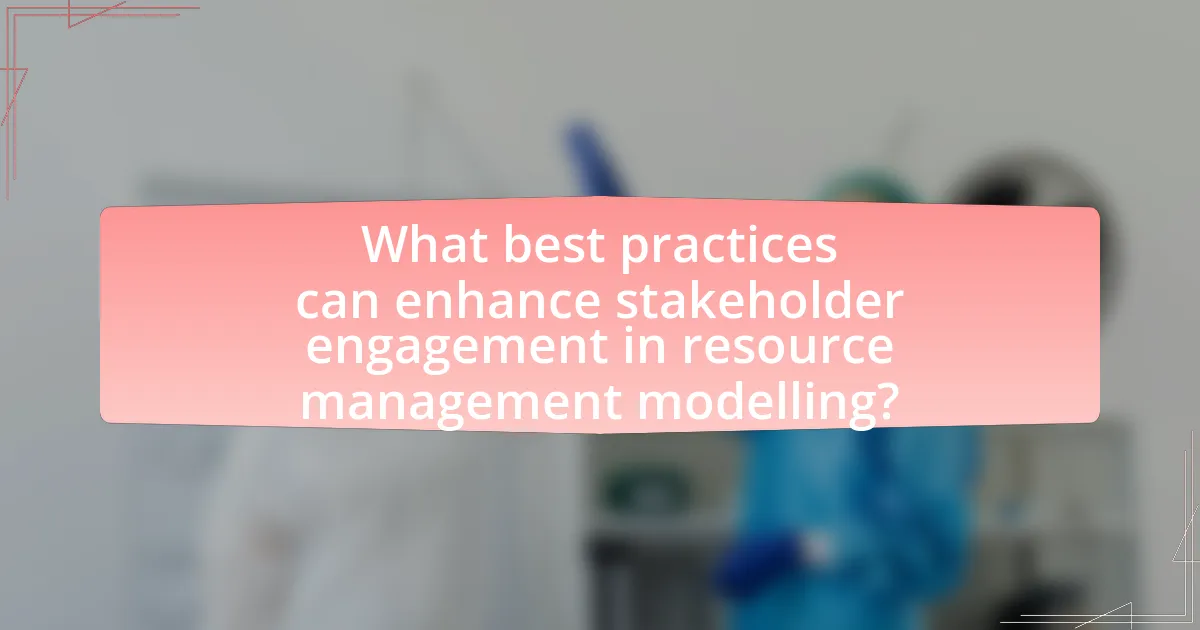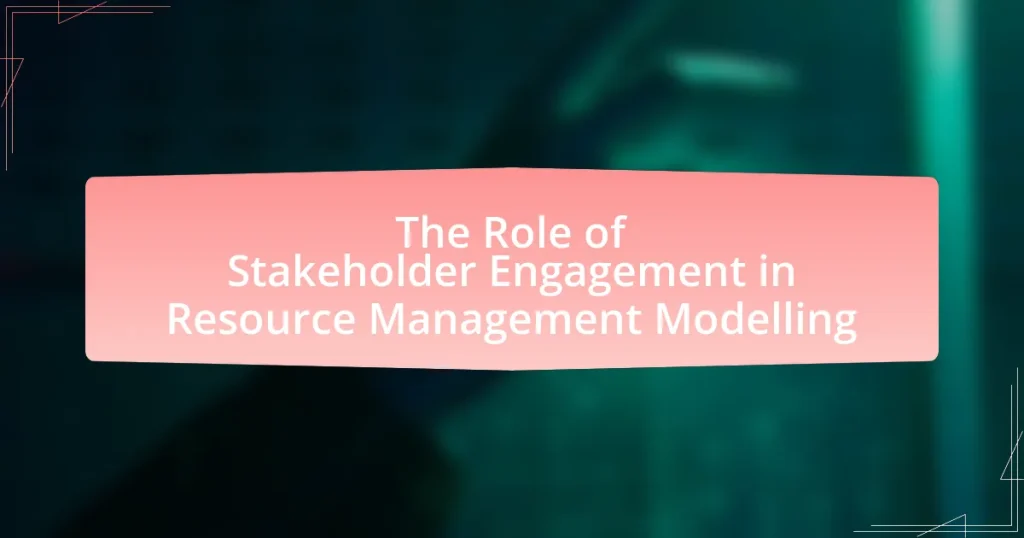Stakeholder engagement is a vital component of resource management modeling, ensuring that diverse perspectives and needs are integrated into decision-making processes. This article explores the significance of stakeholder involvement, highlighting its impact on project success rates, sustainability outcomes, and resource allocation efficiency. Key stakeholders, including government agencies, private companies, NGOs, local communities, and academic institutions, play essential roles in shaping effective resource management strategies. The article also addresses challenges in stakeholder engagement, such as conflicting interests and communication barriers, while offering strategies to enhance participation and mitigate disengagement. Overall, effective stakeholder engagement is shown to improve modeling accuracy and project outcomes, making it a crucial element in resource management practices.

What is the Role of Stakeholder Engagement in Resource Management Modelling?
Stakeholder engagement plays a critical role in resource management modeling by ensuring that diverse perspectives and needs are incorporated into decision-making processes. Engaging stakeholders facilitates the identification of relevant resources, potential conflicts, and collaborative solutions, which enhances the accuracy and effectiveness of resource management models. Research indicates that inclusive stakeholder participation leads to more sustainable outcomes, as evidenced by case studies where stakeholder input improved model reliability and stakeholder satisfaction (Reed et al., 2009, “Who’s in the Room? A Systematic Review of Stakeholder Engagement in Environmental Management”).
Why is stakeholder engagement important in resource management?
Stakeholder engagement is crucial in resource management because it ensures that diverse perspectives and needs are considered, leading to more effective decision-making. Engaging stakeholders fosters collaboration, enhances transparency, and builds trust, which are essential for successful resource allocation and management. Research indicates that projects with active stakeholder involvement are 30% more likely to succeed, as they align resources with community needs and expectations, ultimately resulting in sustainable outcomes.
What are the key stakeholders involved in resource management modelling?
The key stakeholders involved in resource management modelling include government agencies, private sector companies, non-governmental organizations (NGOs), local communities, and academic institutions. Government agencies are responsible for policy-making and regulatory frameworks that guide resource management practices. Private sector companies often provide funding and technological expertise, while NGOs advocate for sustainable practices and represent community interests. Local communities are directly affected by resource management decisions and contribute traditional knowledge and local insights. Academic institutions conduct research and provide data analysis to inform decision-making processes. Each stakeholder plays a crucial role in ensuring that resource management modelling is effective and inclusive, thereby enhancing sustainability outcomes.
How does stakeholder engagement influence decision-making processes?
Stakeholder engagement significantly influences decision-making processes by ensuring that diverse perspectives and interests are considered, leading to more informed and effective outcomes. Engaging stakeholders allows decision-makers to gather valuable insights, identify potential risks, and enhance the legitimacy of decisions. For instance, a study by the International Association for Public Participation found that projects with active stakeholder involvement are 30% more likely to succeed, demonstrating the tangible benefits of incorporating stakeholder feedback into decision-making.
What are the main challenges in stakeholder engagement for resource management?
The main challenges in stakeholder engagement for resource management include conflicting interests, communication barriers, and lack of trust. Conflicting interests arise when stakeholders prioritize different outcomes, making consensus difficult. Communication barriers often stem from varying levels of understanding and expertise among stakeholders, which can lead to misunderstandings and misalignment of goals. Additionally, lack of trust can hinder collaboration, as stakeholders may be skeptical of each other’s intentions or capabilities. These challenges are supported by research indicating that effective stakeholder engagement is crucial for successful resource management, as highlighted in studies by Reed et al. (2009) in “Who’s in the ‘Room’?” and by the United Nations Development Programme, which emphasizes the importance of inclusive decision-making processes.
How can conflicting interests among stakeholders be managed?
Conflicting interests among stakeholders can be managed through effective communication and negotiation strategies. Establishing open lines of communication allows stakeholders to express their concerns and priorities, fostering an environment of collaboration. Utilizing negotiation techniques, such as interest-based bargaining, helps identify common goals and facilitates compromise. Research indicates that stakeholder engagement processes, when structured properly, can lead to more sustainable outcomes, as seen in the case of the Collaborative Governance Framework, which emphasizes shared decision-making and mutual respect among stakeholders. This approach not only addresses conflicts but also enhances trust and cooperation, ultimately leading to more effective resource management.
What strategies can enhance stakeholder participation?
To enhance stakeholder participation, organizations can implement strategies such as fostering open communication, involving stakeholders in decision-making processes, and providing education and training opportunities. Open communication ensures that stakeholders feel heard and valued, which can increase their willingness to engage. Involving stakeholders in decision-making allows them to contribute their insights and expertise, leading to more informed and accepted outcomes. Additionally, providing education and training equips stakeholders with the knowledge necessary to participate effectively, thereby increasing their confidence and engagement levels. These strategies have been shown to improve stakeholder satisfaction and collaboration, ultimately leading to more successful resource management outcomes.

How does stakeholder engagement impact resource management outcomes?
Stakeholder engagement significantly enhances resource management outcomes by fostering collaboration and ensuring that diverse perspectives are considered in decision-making processes. Engaged stakeholders contribute valuable insights that lead to more effective resource allocation, improved project sustainability, and increased community support. For instance, a study by the International Institute for Environment and Development found that projects involving stakeholder participation are 30% more likely to succeed in achieving their objectives compared to those that do not involve stakeholders. This evidence underscores the critical role of stakeholder engagement in optimizing resource management strategies.
What are the benefits of effective stakeholder engagement?
Effective stakeholder engagement enhances project success by fostering collaboration, improving decision-making, and increasing stakeholder satisfaction. Engaging stakeholders ensures that diverse perspectives are considered, leading to more informed and balanced outcomes. Research indicates that projects with high stakeholder involvement are 20% more likely to succeed, as they align project goals with stakeholder needs and expectations. Additionally, effective engagement can reduce resistance to change, as stakeholders feel valued and heard, ultimately leading to smoother implementation of resource management strategies.
How does stakeholder engagement improve resource allocation efficiency?
Stakeholder engagement improves resource allocation efficiency by ensuring that the needs and priorities of all relevant parties are considered in decision-making processes. When stakeholders are actively involved, organizations can gather diverse perspectives, leading to more informed and effective allocation of resources. For example, a study by the International Association for Public Participation found that projects with high stakeholder engagement are 30% more likely to meet their objectives, indicating that understanding stakeholder needs directly influences resource distribution. This collaborative approach minimizes waste and enhances the alignment of resources with actual demands, ultimately leading to more efficient outcomes.
What role does stakeholder feedback play in modelling accuracy?
Stakeholder feedback is crucial for enhancing modelling accuracy as it provides insights that reflect real-world conditions and user needs. By incorporating diverse perspectives from stakeholders, modellers can identify gaps, validate assumptions, and adjust parameters to better align with actual experiences and expectations. Research indicates that models informed by stakeholder input tend to achieve higher predictive accuracy, as evidenced by a study published in the journal “Environmental Modelling & Software,” which found that stakeholder engagement improved model performance by up to 30% in resource management scenarios. This demonstrates that stakeholder feedback not only enriches the modelling process but also leads to more reliable and applicable outcomes.
How can stakeholder engagement be measured in resource management?
Stakeholder engagement in resource management can be measured through various quantitative and qualitative metrics, including surveys, participation rates, and feedback mechanisms. Surveys can assess stakeholder satisfaction and perceived effectiveness of engagement efforts, while participation rates in meetings or decision-making processes provide a quantitative measure of engagement levels. Additionally, feedback mechanisms, such as focus groups or interviews, can yield qualitative insights into stakeholder perspectives and concerns. Research indicates that effective stakeholder engagement correlates with improved project outcomes, as evidenced by a study published in the Journal of Environmental Management, which found that projects with higher stakeholder involvement had a 30% greater success rate in achieving resource management goals.
What metrics are used to assess stakeholder involvement?
Metrics used to assess stakeholder involvement include participation rates, feedback quality, and stakeholder satisfaction scores. Participation rates measure the number of stakeholders engaged in activities, indicating the level of interest and involvement. Feedback quality assesses the relevance and constructiveness of stakeholder input, which reflects their engagement depth. Stakeholder satisfaction scores gauge how stakeholders perceive their involvement and the effectiveness of communication, providing insights into the overall engagement process. These metrics are essential for evaluating the effectiveness of stakeholder engagement strategies in resource management modeling.
How can qualitative feedback be integrated into resource management models?
Qualitative feedback can be integrated into resource management models by systematically collecting and analyzing stakeholder insights to inform decision-making processes. This integration involves utilizing methods such as interviews, focus groups, and surveys to gather diverse perspectives, which can then be translated into actionable data points within the models. For instance, the inclusion of qualitative data allows for a more nuanced understanding of stakeholder priorities and concerns, enhancing the model’s relevance and effectiveness. Research indicates that models incorporating stakeholder feedback lead to improved outcomes, as seen in case studies where stakeholder engagement resulted in more sustainable resource allocation strategies.

What best practices can enhance stakeholder engagement in resource management modelling?
Best practices that can enhance stakeholder engagement in resource management modelling include establishing clear communication channels, involving stakeholders early in the process, and providing regular updates on project progress. Clear communication channels ensure that stakeholders can voice their concerns and suggestions, fostering a collaborative environment. Involving stakeholders early allows for their insights to shape the modelling process, leading to more relevant and accepted outcomes. Regular updates keep stakeholders informed and engaged, reinforcing their investment in the project. Research indicates that projects with high stakeholder engagement are 30% more likely to succeed, highlighting the importance of these practices in achieving effective resource management outcomes.
How can technology facilitate stakeholder engagement?
Technology facilitates stakeholder engagement by providing platforms for real-time communication and collaboration. Tools such as online forums, social media, and project management software enable stakeholders to share insights, feedback, and updates efficiently. For instance, a study by the International Association for Public Participation found that digital engagement methods can increase participation rates by up to 50%, demonstrating the effectiveness of technology in enhancing stakeholder involvement. Additionally, data analytics tools allow organizations to analyze stakeholder sentiments and preferences, leading to more informed decision-making and tailored engagement strategies.
What tools are available for effective communication with stakeholders?
Effective communication with stakeholders can be achieved through various tools, including project management software, collaboration platforms, and communication applications. Tools like Microsoft Teams and Slack facilitate real-time messaging and file sharing, enhancing collaboration among stakeholders. Additionally, project management tools such as Asana and Trello allow for tracking progress and assigning tasks, ensuring transparency and accountability. Video conferencing tools like Zoom and Google Meet enable face-to-face interactions, which can strengthen relationships and clarify complex issues. These tools collectively support effective stakeholder engagement by promoting clarity, collaboration, and timely information sharing.
How can data visualization improve stakeholder understanding?
Data visualization enhances stakeholder understanding by transforming complex data into accessible visual formats, such as charts and graphs. This simplification allows stakeholders to quickly grasp trends, patterns, and insights that may be obscured in raw data. For instance, a study by the Data Visualization Society found that visual representations can improve information retention by up to 65%, compared to text-based data alone. By presenting data visually, stakeholders can engage more effectively in discussions, make informed decisions, and align their strategies with organizational goals.
What are common pitfalls to avoid in stakeholder engagement?
Common pitfalls to avoid in stakeholder engagement include failing to identify key stakeholders, neglecting to communicate effectively, and not managing expectations. Identifying key stakeholders is crucial because overlooking influential parties can lead to resistance and project failure. Effective communication ensures that stakeholders are informed and engaged, while poor communication can result in misunderstandings and disengagement. Additionally, managing expectations is vital; if stakeholders have unrealistic expectations, it can lead to dissatisfaction and conflict. Research indicates that projects with clear stakeholder engagement strategies are 20% more likely to succeed, highlighting the importance of avoiding these pitfalls.
How can miscommunication be prevented during the engagement process?
Miscommunication during the engagement process can be prevented by establishing clear communication protocols and ensuring all stakeholders are aligned on objectives. Implementing regular check-ins and feedback loops allows for clarification of expectations and addresses misunderstandings promptly. Research indicates that organizations with structured communication strategies experience 25% fewer project delays due to miscommunication, highlighting the effectiveness of these practices in enhancing stakeholder engagement.
What strategies can mitigate stakeholder disengagement?
To mitigate stakeholder disengagement, organizations can implement regular communication, inclusive decision-making processes, and targeted feedback mechanisms. Regular communication ensures stakeholders are informed about project developments, fostering a sense of involvement and transparency. Inclusive decision-making allows stakeholders to contribute their insights and opinions, which enhances their commitment and ownership of the project. Targeted feedback mechanisms, such as surveys or focus groups, enable stakeholders to express their concerns and suggestions, demonstrating that their input is valued and considered. Research indicates that organizations employing these strategies experience higher levels of stakeholder satisfaction and engagement, leading to more successful project outcomes.
What practical tips can improve stakeholder engagement in resource management modelling?
To improve stakeholder engagement in resource management modelling, it is essential to establish clear communication channels. Effective communication fosters transparency and trust, which are critical for stakeholder involvement. Regular updates and feedback sessions can ensure stakeholders feel valued and informed, enhancing their commitment to the modelling process. Additionally, involving stakeholders in the decision-making process allows them to contribute their insights and expertise, leading to more comprehensive and accepted resource management strategies. Research indicates that participatory approaches, where stakeholders actively engage in discussions and decisions, significantly increase the likelihood of successful project outcomes.


